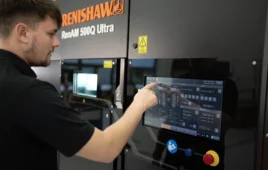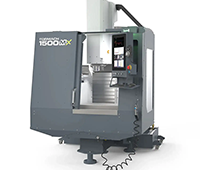
THK’s Type SRS15 LM Guide installed in the Pocket NC
As components are growing smaller, developers are dreaming bigger. Reduced sizing and pricing of parts has opened the door to more innovations from engineers and inventors and is giving greater access to end-users.
In 2011, recognizing the need for a compact 5-axis milling machine, Pocket NC founders Matt and Michelle Hertel started designing the Pocket NC. With backgrounds as a machinist and a mechanical engineer, the husband and wife team developed the first 5-axis milling machine designed for desktop use. They launched the Pocket NC on Kickstarter in 2015. The company solely manufactures, assembles, and distributes the Pocket NC from its 6,500 sq. ft. Bozeman, Montana facility.
“In the past, the drive that controls the motors would have been as big as the machine and it would have cost significantly more. Today, the electronics that allow motor control are a quarter of the size and a small percentage of the cost,” explained Hertel. This is true of other Pocket NC components as well.
Hertel specified THK LM Guides based on previous experience. “I had used mechanisms from just about every company out there and learned what components I like for various reasons,” continued Hertel. “Our decision to use THK linear guides was based on accuracy, ease of assembly, and how consistent they are from one rail to another.”
With a rail as small as 7mm, the Type SRS Miniature LM Guide is optimal for the Pocket NC application. The incorporation of patented Caged Technology, where a synthetic resin cage with a curvature that cradles each ball and separates it from the next, ensures smooth motion, increased speed and accuracy, low dust generation, and long life. The spaces between the rolling elements retain grease and act as a lubrication system for long-term maintenance-free operation.
The guides keep the balls from rolling against each other or falling out. Other LM guides created problems during the assembly process. With the Type SRS, the bearing cars could be removed and the linear rails installed with the balls remaining in place.

THK’s Type RAU Cross-Roller Ring is used in the A- and B-axis of the Pocket NC
The X-axis and Y-axis of the Pocket NC each use two THK Type SRS9 LM Guides, while the Z-axis uses one THK Type SRS15 LM Guide.
Pocket NC designed its machine with an additional component to further ensure precision. The RAU Cross-Roller Ring is used for the rotary axes to provide stable and accurate rotation. Incorporated in the A-axis and B-axis of the Pocket NC, the spacer retainers of the micro-size roller ring enable smooth movement and high rotation precision. Using a 10mm inner diameter and a 21mm outer diameter, the Type RAU is more compact, lightweight, and rigid than a double row angular contact ball bearing type. RAU rollers travel on V-shaped raceways ground into the inner and outer rings. Alternating rollers are arrayed orthogonally so that one bearing can support loads and moments in any direction.
Prototype labs make up 40% of the Pocket NC market, while the education industry makes up 50% of the market. Recognizing the value in a desktop milling machine, more and more universities are adding Pocket NCs to their manufacturing lab equipment list.
“Engineering students don’t usually have access to full-size machines. The Pocket NC gives them access to and experience with using an actual milling machine,” said Hertel. Individuals make up the remaining 10% of the Pocket NC market.

The Pocket NC V2-50DA trimming a dental aligner
The Pocket NC operates with most common CAM software packages and is available in V2-50 and V2-10 models, each with a 16 x 8-ft footprint. The Pocket NC V2-50 is suitable for fast, narrow, and deep machining. Applications include jewelry, medical, and dental, including prototypes. Some specifications: 1,000-50,000 RPM spindle speeds, tool diameters up to ⅛-in. (3.2mm), ER11 collet, spindle runout 0.0005-in. (12.7 µm).
The Pocket NC V2-10 is a lower-cost option. Some specifications: 2,000-10,000 RPM spindle speeds, tool diameters up to ¼-in. (6.35mm), CHB (⅛-in., 3mm, 4mm) collet, spindle runout 0.000-in. (2.5 µm).
THK America
www.thk.com
Filed Under: MANUFACTURING




